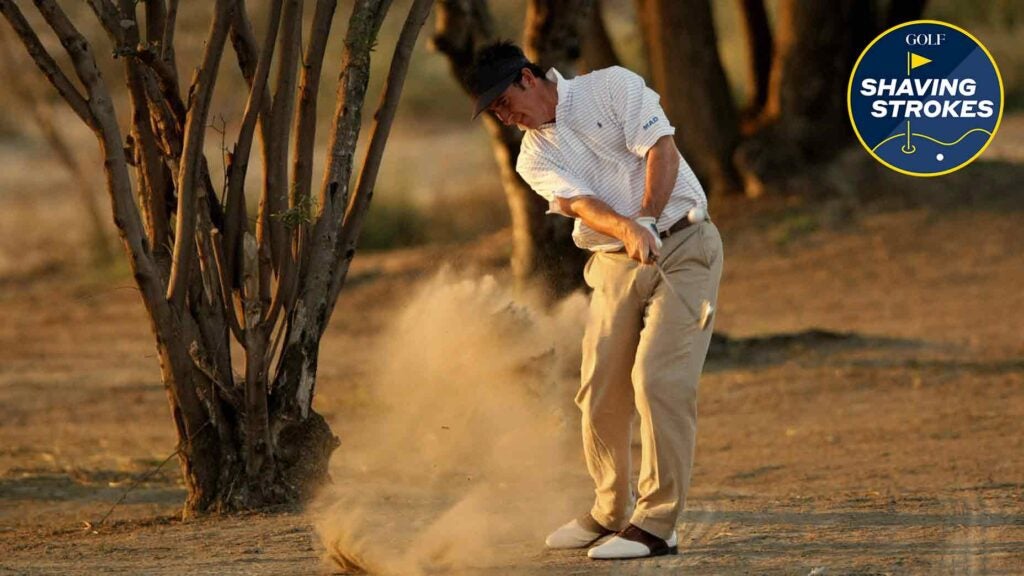Golf is a sport that involves hitting a small ball into a series of holes on a course using various clubs. It requires precision, skill, and strategy.
Golfers aim to complete each hole in as few strokes as possible. The game is played on a large outdoor course, usually consisting of 9 or 18 holes. Golf is a popular sport worldwide, attracting both amateur and professional players.
It offers numerous physical and mental benefits, including improved cardiovascular health, enhanced focus, and stress relief. Players can enjoy the game individually or in groups, making it a versatile and inclusive sport for all ages and skill levels. So, whether you’re new to golf or an experienced player, the game offers an enjoyable and challenging experience for everyone.

Credit: golf.com
1. The Importance Of A Good Golf Swing
When it comes to playing golf, having a good swing is absolutely crucial. Your swing is the foundation of your game, affecting everything from accuracy to distance. In order to improve your swing and ultimately become a better golfer, you need to focus on various aspects of your technique. Let’s dive into the key elements that play a vital role in shaping your golf swing.
1.1 Proper Body Alignment
Proper body alignment is the first step toward developing a consistent and effective golf swing. It involves positioning your body in a way that allows for maximum power and accuracy. To achieve this, stand parallel to your target line, with your feet shoulder-width apart. Your hips, shoulders, and feet should be aligned with the target. This alignment helps you maintain balance and stability, promoting a smooth and controlled swing.
1.2 Grip And Hand Positioning
Your grip and hand positioning are critical components of a good golf swing. The grip is your connection to the club, influencing your control and feel throughout the swing. To achieve a proper grip, place the club’s handle in the fingers of your left hand (for right-handed players), forming a “V” between your thumb and index finger. The right hand should grip the club with the fingers, with the thumb resting slightly to the right of center. This neutral grip allows for better clubface control, ensuring solid contact with the ball.
1.3 Swing Plane And Path
The swing plane and path refer to the trajectory and direction of your swing. To optimize your swing plane, imagine a tilted hula hoop around your body, angled slightly forward. During your backswing, the clubhead should trace this imaginary hoop, moving along the same plane. This promotes a consistent swing and prevents any excessive movements that may affect the accuracy of your shots. Additionally, the swing path refers to the direction your club travels during impact. Aim for a slightly inside-to-out path, as this helps to square the clubface at impact and produce straighter shots.
In conclusion, a good golf swing is the foundation of a successful game. To achieve a great swing, focus on proper body alignment, grip, and hand positioning, as well as swing plane and path. By mastering these key elements, you’ll be well on your way to improving your golf skills and enjoying greater success on the course.

Credit: www.walmart.com
2. Mastering The Fundamentals
When it comes to golf, mastering the fundamentals is essential for improving your game. These fundamental elements lay the foundation for a successful swing and consistent performance on the course. In this section, we will explore the key aspects of the golf swing that you should focus on to enhance your skills. By developing a consistent setup routine, understanding and perfecting the takeaway, achieving a powerful backswing, executing an efficient transition and downswing, and mastering impact and follow-through, you can take your golf game to the next level.
2.1 Developing A Consistent Setup Routine
A consistent setup routine is crucial for every golf shot as it establishes the correct alignment, posture, and grip. By developing a reliable setup routine, you create a solid foundation for a successful swing. Start by positioning your feet shoulder-width apart, parallel to the target line. Ensure your weight is evenly distributed on both feet, promoting balance and stability throughout the swing. Maintain a slight flex in your knees and a straight back to achieve an optimal posture. Lastly, grip the club with your lead hand placed on top of the handle, and the trailing hand supporting from below. This grip should be firm but not overly tight, allowing for maximum control.
2.2 Understanding And Perfecting The Takeaway
The takeaway is the initial movement that sets the tone for the entire golf swing. It’s important to understand and perfect this crucial phase to ensure a smooth and consistent swing. Start by initiating the takeaway with your shoulders, keeping them square to the target line. As you begin your backswing, let your arms and hands remain relaxed, allowing them to follow the rotation of your shoulders naturally. Avoid any sudden or jerky movements that can disrupt the fluidity of your swing. By focusing on a synchronized takeaway, you can set yourself up for a powerful and controlled swing.
2.3 Achieving A Powerful Backswing
The backswing plays a significant role in generating power and creating potential energy for an explosive downswing. To achieve a powerful backswing, focus on rotating your shoulders fully while maintaining a stable lower body. This rotation allows you to create the necessary torque for maximum clubhead speed and distance. Keep your wrists firm yet supple, maintaining control throughout the motion. As you reach the top of your backswing, ensure that your weight is primarily on your trail foot, ready to transfer to the front during the downswing. By mastering the backswing, you can unleash the full power of your swing.
2.4 Efficient Transition And Downswing
The transition from the backswing to the downswing is a critical moment that requires a seamless transfer of energy. Aim for an efficient transition by initiating the downswing with the lower body, specifically the hips. This movement will initiate the rotation of your torso and arms, allowing for a smooth and powerful swing. Keep your arms connected to your body during this phase, avoiding any excessive separation that can lead to loss of control. As you approach impact, transfer your weight from the trail foot to the lead foot, ensuring a solid strike and optimal power transfer.
2.5 Impact And Follow-through
The impact and follow-through are the final stages of the golf swing where all the elements come together for a successful shot. At impact, focus on striking the ball with the center of the clubface, achieving maximum distance and accuracy. Your hands should be leading the clubhead at this point, creating a crisp and powerful strike. As you complete your swing, maintain a balanced and controlled follow-through, allowing your body to naturally rotate towards the target. This follow-through ensures proper weight transfer and promotes a smooth finish to your swing. By mastering impact and follow-through, you can consistently execute strong and accurate shots.
3. Perfecting Your Golf Swing
3. Perfecting Your Golf Swing
Perfecting your golf swing is pivotal to improving your game and achieving better results on the course. Whether you’re a beginner or a seasoned player, refining your swing is an ongoing process that requires dedication, technique, and the right approach. Let’s delve into the essential strategies and tips to help you perfect your golf swing.
3.1 Analyzing Your Swing With Video Technology
- Record your swings from various angles to identify flaws
- Use slow-motion replay to scrutinize your movement and form
- Compare your swing with professional golfers for benchmarking
3.2 Practicing With Purpose
- Focus on specific aspects of your swing during practice sessions
- Work on consistency, balance, and follow-through
- Engage in purposeful drills to address weaknesses and enhance strengths
3.3 Seeking Professional Guidance
Enlisting the expertise of a golf instructor can provide valuable insights and personalized feedback tailored to your individual needs. Professional guidance can significantly accelerate your progress and help you overcome persistent swing challenges.
3.4 Improving Swing Tempo And Rhythm
Emphasize the importance of tempo and rhythm in your swing, ensuring a smooth and controlled motion that optimizes power and accuracy. Practice drills that focus on tempo to develop a consistent and fluid swing.
3.5 Fine-tuning Your Swing Mechanics
Refine your swing mechanics by paying attention to grip, posture, alignment, and club position. Small adjustments in these fundamental aspects can vastly improve the quality and precision of your swing.

Credit: www.amazon.com
4. Avoiding Common Swing Mistakes
Golf is a game that requires precision and skill, and mastering the golf swing is crucial for success on the course. In order to refine your technique, it’s essential to avoid common swing mistakes that can compromise your game. By honing in on these issues and making the necessary adjustments, players can elevate their performance and experience greater consistency and accuracy on the course.
4.1 Overcoming The Slice Or Hook
The slice and hook are two of the most common swing problems that plague golfers. To overcome these issues, focus on proper grip and alignment, as well as ensuring a smooth, balanced swing. Engage in targeted practice drills to correct these swing path issues and achieve desired ball flight.
4.2 Dealing With Inconsistent Ball Contact
Inconsistent ball contact can stem from a variety of factors, including improper alignment, weight distribution, and clubface angle at impact. By working with a professional coach or utilizing swing analysis tools, golfers can identify and rectify issues with their swing to achieve consistent ball contact.
4.3 Eliminating The Dreaded ‘yips’
The ‘yips’ refer to involuntary muscle spasms or jerks that can disrupt a golfer’s putting stroke. Overcoming the ‘yips’ involves mental and physical training, including relaxation techniques, visualization, and refining putting mechanics. By addressing these aspects, golfers can regain confidence and control on the greens.
4.4 Preventing A Chicken Wing
A ‘chicken wing’ occurs when the lead arm bends excessively through impact, resulting in a weaker, less efficient swing. To prevent this, focus on maintaining a straight lead arm post-impact and engaging in drills that promote proper extension and rotation through the ball.
4.5 Addressing Swing Faults Specific To Your Body Type
Every golfer has a unique body type, and swing faults may arise due to physical limitations or strengths. Working with a knowledgeable instructor to tailor your swing to your body type can result in improved consistency and performance on the course.
5. Mental Aspect Of The Golf Swing
Golf is not just a physical game but also a mental one. The mental aspect of the golf swing plays a crucial role in a golfer’s overall performance and success on the course. Developing a proper pre-shot routine, managing swing thoughts, building confidence, overcoming frustrations, and visualizing success are all key elements that contribute to a golfer’s mental game. In this section, we will explore these aspects in detail to help you improve your mental game and enhance your golfing experience.
5.1 Developing A Pre-shot Routine
A pre-shot routine is the set of actions and thoughts a golfer goes through before executing a shot. Having a consistent pre-shot routine helps create a mental and physical trigger, allowing golfers to focus their attention on the task at hand. A typical pre-shot routine includes steps like visualizing the shot, selecting the club, aligning the body, and taking a practice swing. By following this routine before every shot, you can establish a rhythm and improve your consistency on the course.
5.2 Managing Swing Thoughts And Focusing On The Target
When it comes to golf, overthinking can be detrimental to your performance. Golfers often have numerous swing thoughts running through their minds, which can lead to tension and inconsistency in their swing. Instead, it is important to simplify your thoughts and focus on the target. By adopting a clear and focused mindset, you can enhance your ability to execute shots with precision and accuracy.
5.3 Building Confidence And Handling Pressure
Confidence is a key component of a successful mental game in golf. Building confidence requires practice, experience, and a positive mindset. It is important to believe in your abilities and trust your skills under pressure. Managing pressure situations and handling nerves allows you to perform at your best even in challenging circumstances. Developing mental strategies such as positive self-talk, deep breathing, and visualization can help boost your confidence and optimize your performance on the course.
5.4 Overcoming Swing-related Frustrations
Swing-related frustrations are common in golf, but they can be overcome by adopting a resilient mindset. It is important to understand that setbacks and bad shots are part of the game. Instead of dwelling on past mistakes, focus on learning from them and making necessary adjustments. Developing patience and maintaining a positive attitude will help you overcome frustrations and stay focused on your game.
5.5 Visualizing Success And Positive Outcomes
Visualization is a powerful mental tool that can significantly impact your golf game. By visualizing successful shots and positive outcomes, you can program your mind to replicate those desired results. This technique helps improve focus, confidence, and muscle memory. Before each shot, take a moment to vividly imagine the ball’s trajectory and landing spot. Visualizing success will enhance your ability to execute the shot and increase your chances of achieving your desired outcome.
Frequently Asked Questions On How Golf
How Do You Play The Game Of Golf?
Golf is played by hitting a small ball into a series of holes using clubs. Players aim to complete each hole in as few strokes as possible. The game requires strategy, skill, and precision. Get ready to tee up, swing, and have a great time on the course!
How Do You Play Golf Basics?
To play golf basics, focus on some key aspects. First, grip the club with both hands. Then, stand with your feet shoulder-width apart, facing the target. Swing the club back and forth, aiming to hit the ball with the clubface.
Keep practicing to improve your skills over time.
What Are The 7 Steps To Golf?
The 7 steps to golf are: 1) Grip the club correctly, 2) Stance and alignment, 3) Takeaway, 4) Backswing, 5) Downswing, 6) Impact, and 7) Follow-through. Mastering these steps can help improve your golf game.
How Do You Play Golf Effectively?
To play golf effectively, focus on proper grip, stance, and alignment. Practice your swing and aim for consistency. Improve your short game by practicing putting and chipping. Understand course management and play strategically. Stay relaxed and focused during the game.
Keep practicing to improve your skills.
Conclusion
To truly grasp the captivating allure of golf, one must step onto the course and experience the sport firsthand. The unique blend of skill, strategy, and precision required to master this timeless game is unparalleled. Whether you’re a seasoned player or just starting out, the peace and tranquility found amidst the rolling greens provide the perfect escape from the hustle and bustle of everyday life.
So, embrace the challenge, embrace the serenity, and let the world of golf open its doors to a lifetime of joy and fulfillment.









